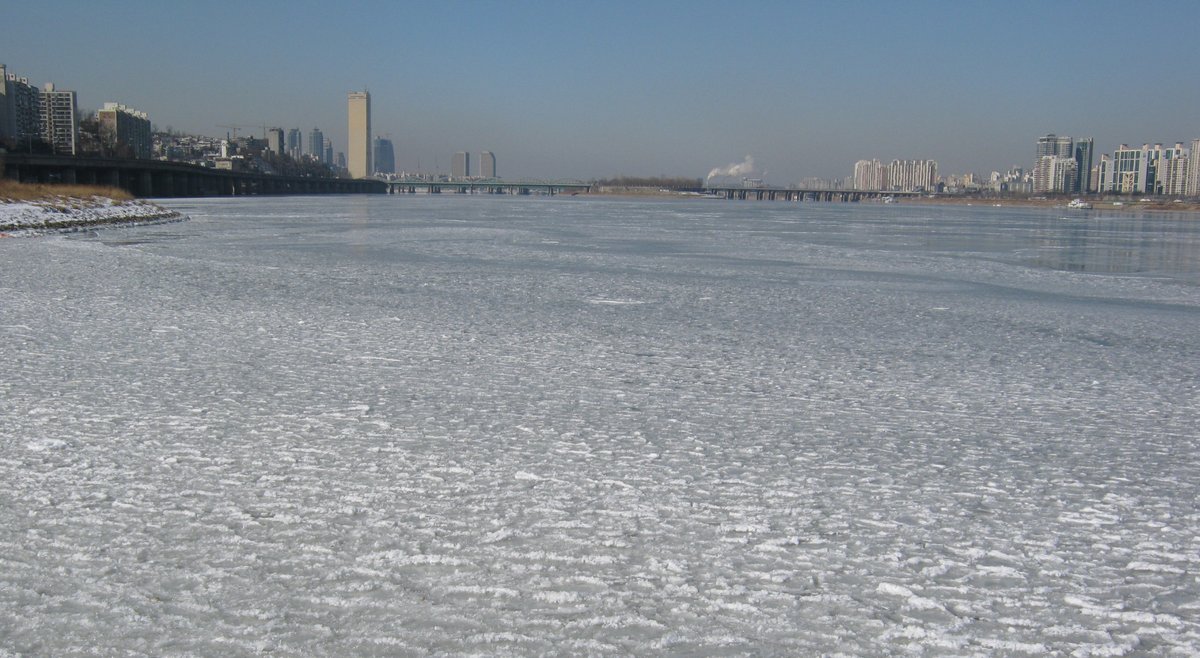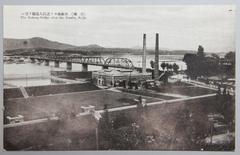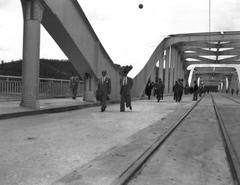
Hangang Bridge: Visiting Hours, Tickets, and Complete Guide to Seoul’s Historic Landmark
Date: 14/06/2025
Introduction
The Hangang Bridge stands as one of Seoul’s most enduring symbols, encapsulating the city’s journey from imperial crossroads to modern metropolis. Spanning the Han River and linking Yongsan-gu and Dongjak-gu, this historic bridge is not just a crucial transportation route but a living monument to Korea’s resilience, innovation, and community spirit. From its early 20th-century origins, through war and reconstruction, to its present-day role as a hub for recreation, culture, and remembrance, Hangang Bridge offers visitors an immersive experience at the heart of Seoul (Wikipedia; Korean Heritage).
This comprehensive guide covers Hangang Bridge’s history, architectural highlights, visiting hours, ticketing, accessibility details, festivals, nearby attractions, and practical tips for making the most of your visit. Whether you’re a history buff, urban explorer, or leisure traveler, discover why Hangang Bridge remains a must-see destination in Seoul (Seoul Metropolitan Government; Trip.com).
Table of Contents
- Historical Overview
- Architectural Features
- Visitor Information
- Events & Festivals
- Recommended Activities
- Nearby Attractions
- FAQs
- Conclusion & Visitor Recommendations
- References
Historical Overview
Early Origins and Construction
The present site of Hangang Bridge has long played a pivotal role in Seoul’s development, historically serving as a crossing point over the Han River. Before the construction of permanent bridges, temporary pontoons facilitated crossings, but these were often washed away by floods (Wikipedia). The completion of Hangang Railway Bridge in 1900 marked a technological leap, while the first footbridge—Indogyo—opened in 1917, accommodating pedestrians and light traffic.
Expansion, Upgrades, and the Korean War
After severe flooding in 1925 severely damaged the original structure, a second span and tram tracks were added in 1935 to meet the city’s growing transportation needs (Wikipedia). Hangang Bridge’s most challenging hour came during the Korean War. In June 1950, South Korean forces demolished the bridge to hinder the North Korean advance, tragically without warning civilians, resulting in hundreds of deaths (modos.co.nz). The bridge was rebuilt in 1954, symbolizing the nation’s post-war resolve.
Modernization
Seoul’s rapid urbanization led to further expansions, including an eight-lane upgrade in 1982 and the official renaming to “Hangang Bridge” (Hangangdaegyo). Today, it remains a vital connector for vehicles, cyclists, and pedestrians, integrating with the artificial Nodeulseom Island (Trek Zone).
Architectural Features
Structural Design
Hangang Bridge’s robust multi-span design supports heavy daily traffic and resists the Han River’s seasonal challenges (modos.co.nz). Piers anchored into the riverbed provide resilience against flooding, and the elevated deck allows for uninterrupted river navigation (Wikipedia).
Integration with Nodeulseom Island
One of the bridge’s distinguishing features is its passage over Nodeulseom, an artificial island transformed into a green cultural space with lawns, art installations, and performance venues (Seoul Metropolitan Government).
Nighttime Illumination and Amenities
The southern end of the bridge is illuminated at night, creating a striking cityscape. There are cafés offering exceptional river and skyline views, making this a popular evening destination for both locals and tourists.
Proximity to Other Landmarks
Nearby bridges like Banpo (with its famed Rainbow Fountain) and Mapo, along with Hangang Park, offer additional opportunities for sightseeing and recreation (Buzzsetter).
Visitor Information
Visiting Hours & Accessibility
- Hangang Bridge: Open 24/7. No entrance fee.
- Nodeulseom Island: Typically open 10:00 AM–10:00 PM. Hours may vary during events; check official site for updates.
- Accessibility: Wheelchair-friendly with ramps, elevators, and accessible restrooms. Subway and bus routes offer easy access.
How to Get There
- Subway Stations: Ichon (Line 4, Gyeongui–Jungang Line), Nodeul (Line 9), and Dongjak (Line 4/9).
- Bus Routes: Multiple city buses serve both bridge ends.
- Cycling: Part of the extensive Han River cycling trail network. Bike rentals are available at nearby parks.
Facilities
- Restrooms: Available at both bridge ends and in adjacent parks.
- Convenience Stores: Near entrances for snacks and supplies.
- Bike Rentals: At Han River parks, including Banpo and Yeouido.
Travel Tips
- Best Seasons: Spring (cherry blossoms), autumn (foliage), and evenings for illuminated city views (Asia Highlights).
- Weather: Summer is hot/humid; pack sunscreen and water. Rain gear is useful during monsoon season (Hey Roseanne).
- Dress & Safety: Comfortable walking shoes recommended. The area is safe and well-lit, but always mind personal belongings during events.
Events & Festivals
Hangang River Festival
Held annually in August, the Hangang River Festival transforms the bridge into a pedestrian promenade with outdoor libraries, flea markets, performances, and food trucks. During the festival, vehicular traffic is restricted, so check schedules for access updates (Seoul Metropolitan Government).
Car-Free Jamsugyo Bridge Festival
The adjacent Jamsugyo Bridge hosts its own car-free festival from May to June, featuring art installations, wellness programs, and unique riverside views (Stripes Korea).
Hangang Space-Out Competition
A quirky wellness event sometimes held near Hangang Bridge, inviting participants to relax and “do nothing” for 90 minutes—perfect for experiencing the river’s tranquil side (Seoul Metropolitan Government).
Recommended Activities
- Walking & Cycling: Enjoy the bridge’s panoramic views on foot or by bike.
- Picnics: Nodeulseom Island is ideal for riverside picnics.
- Night Photography: Capture the illuminated bridge and skyline reflections.
- River Cruises: Sightseeing and dinner cruises depart from docks near the bridge (Hey Roseanne).
- Banpo Bridge Fountain: Don’t miss the world’s longest bridge fountain, best seen at night (Noel in Seoul).
Nearby Attractions
Nodeulseom Island
A revitalized cultural hotspot with performance spaces, art installations, and cafés (Stripes Korea).
Yeouido Hangang Park
Famous for cherry blossoms, river cruises, and large-scale festivals.
Banpo Hangang Park
Site of the Rainbow Fountain and vibrant night markets (Travel-Stained).
Ichon Hangang Park
Offers quiet riverside paths and sports facilities.
Cheonggyecheon Stream
An urban stream close by, with landscaped walkways and art.
FAQs
Q: Is there an entrance fee to visit Hangang Bridge?
A: No, access is free and open 24/7.
Q: How do I get to Hangang Bridge?
A: Subway (Ichon, Nodeul, Dongjak stations), city buses, and Han River bike trails all provide easy access.
Q: Is the bridge wheelchair accessible?
A: Yes, with ramps and elevators at both ends.
Q: Are there guided tours?
A: Several city tours include Hangang Bridge; check with local operators or use travel apps for self-guided options.
Q: What’s the best time to visit?
A: Spring and autumn for pleasant weather and festivals; evenings for city lights.
Q: Are there restrictions during events?
A: During festivals, vehicle access may be limited; consult the city events calendar.
Conclusion & Visitor Recommendations
Hangang Bridge is far more than a river crossing—it’s a living testament to Seoul’s resilience, heritage, and vibrant urban culture. Its open access, integration with Nodeulseom Island, and proximity to celebrated parks and attractions make it a dynamic destination for history, leisure, and community events. Whether you’re cycling along Han River trails, exploring nearby parks, or reflecting on the bridge’s historical significance, Hangang Bridge promises a memorable experience for every visitor (modos.co.nz; Korean Heritage).
To enhance your visit, check out guided tours, attend seasonal festivals, and download the Audiala app for real-time updates and expert tips (Audiala).
References
- Wikipedia – Hangang Bridge
- modos.co.nz – Rediscovering Hangang Bridge
- Korean Heritage – Hangang Bridge Feature
- Trip.com – Visiting Hangang Bridge
- The Soul of Seoul – Hangang Parks Guide
- Seoul Metropolitan Government – Hangang Bridge
- Korea Tourism Organization – Han River
- TripZilla – Guide to Hangang Park
- Korea by Bike – Hangang Railway Bridges
- Buzzsetter – Han River Spots
- Trek Zone – Hangang Bridge
- Hey Roseanne – Summer in Seoul
- Travel-Stained – Banpo Hangang Park
- Noel in Seoul – Han River
- Stripes Korea – Hangang River
- Asia Highlights – Best Time to Visit Korea
- Planit Lets Go – South Korea Itinerary
- Audiala Mobile App
Plan your trip, explore more with our related guides, and follow Audiala for insider tips on Seoul’s historical and cultural gems.














































































































































































































